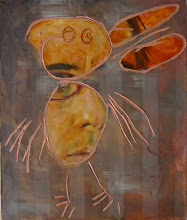I participated in the very interesting BRAG summit on Saturday. As I was on the first panel following David Bromfield's introductory talk about the mechanics of the Survey selection I blathered incoherently for most of my allotted time - more about this later.
It was indeed interesting to hear David speak of his and Pippa Tandy's experiences encountering the South West. Expectations of dirt tracks, mud brick huts and neanderthal artists lay the foundations for their anticipated journey. They were resolutely surprised by the volume, sophistication, depth and dedication of arts practice they encountered however. This was bone picked by local art historian Diana Roberts who took great offence to the stereotyping of artists residing in the country as poor little country bumpkins who couldn't find their way out of a landscape watercolour class if they tried. Whether there is any truth in this is something to be debated no doubt - is it a regional hang-up or a typical generalisation applied by city dwellers considering regional art practice?
Apparently according to David, the South West region of artists has missed out on the global shift in cultural attitude to art and the centre. We seemed to have missed the point made that working from the region is apparently an empowering position. That is of course according to arts writers, historians and critics - a bunch of trend spotters who look for the next 'hot' angle to promote, seek out and conquer in art. Long gone are the Damien Hirst diamond-studded skills to suffocate our senses thanks to the GFC of 2008. Now we see not monumental and 'magnificent' art but apparently genuine, authentic, art of place and identity, belonging and humility. Art that speaks a truth without the dollars and the flash. Apparently.
Interesting to note that artists often ponder lonely hours in their studios contemplating their communication through their medium. If we read and network and google and blog I am sure we mighty stay abreast of these shifting posts - basically trend highlighters. No longer is it fashionable to produce great vast art-wank for multi-billionaires' collections, it is now the 'in-thing' to produce art not connected to the centre, art from where it exists, that reflects a sense of it's circumstance - the global chorus sung by a global tribe of various artists scattered across remote and far-flung places. What I find interesting about this is the chicken-and egg syndrome. Daniel said it is luck to be successful as an artist and i feel he is right. Beaver away in your studio and one day the trend spotlight may seek you out to affirm it's hot-spot ideal. That, my friend, is luck. Luck is not, however a trend-seeking artist who then produces work that fits the current preferential paradigm, that is savvy business sense, clever marketing and astute production, not art.
So I find it interesting that David says we have missed the 'global is in' memo posted on the art history noticeboard. Perhaps we were too busy being 'authentic' working away in our studios to be empowered by a quick mind-shift that we are in fact luck to be practicing where we are. Lucky we are indeed - to seek out exhibition opportunities across state borders that cost more than our annual income to enter, freight, insure and show. Lucky to have an abundance of exhibition spaces available to us, lucky to have curators, arts writers, a population big enough to support our growth and development. I guess if we exist alone in our studios completely internet savvy and well-read we would be in a better position to be globally aware. Quick note for me: i am on satellite broadband and it SUCKS. I can lose HOURS of studio time just trying to understand HOW I might begin to communicate with he rest of the art world about what I am doing....
Apparently we need a center to fight against, to establish a regional identity so that it would be easier for an art historian to make broad generalisations about us (or in my case, include but completely ignore because i do not fit the boxes applied to the region in question or the meta narrative applied to the region in question). Are meta narratives useful in creating meaningful dialogue about a region or a group of artists from a particular area? It makes it easier to create a picture or snap shot of unifying features perhaps, easier to apply a metaphor or allusion...it does not however, do the artists any favour to have their work skewed slightly so that it fits more meaningfully within a package that promotes a meta narrative...(I miss spelt 'meta' as 'meat' and that seemed quite a nice analogy, a meat narrative, all fleshy).
I guess I feel our very real complaints & concerns have been swept aside in view of a preferred critique that makes it easier to generalise and patronise our area. Having our very real problems diminished by an outsider in a position of privilege is no more than a parent reprimanding a child for being too demanding. Our complaints and concerns are very real to us and bear a greater degree than faced by urban artists - isolation, financial support, available exhibition opportunities, lack of cohesive guidance (like Artsource or DCA etc). The sheer cost of transport alone in getting to see shows or trafficking work to and from exhibition needs to be considered before you point out that we missed the boat when the global art trend squad decided we were empowered artists because we lived authentically and could join the global community at will despite our location.
Subscribe to:
Post Comments (Atom)

skin of the beast

- hath
- Derby, Western Australia, Australia
- I am an artist, feminist, teacher, student and m-other among other things. I live in the Kimberley - north west of Western Australia.
No comments:
Post a Comment